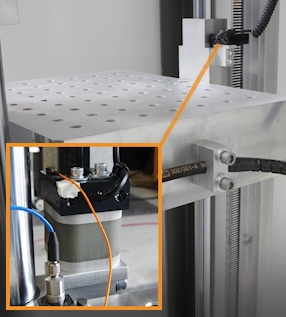The most important shock machine design criteria is the ability to repeatedly subject test items to potentially damaging impacts, without breaking the shock machine itself! We continuously design new shock systems to satisfy increasing performance requirements for our customers. In many cases those performance increases translate to higher impact energy and acceleration levels. While most critical components are isolated from the impact severity, one is mounted to the table and must survive those impacts—the Optical Table Controller (OTC) sensor.
The OTC sensor provides position information used to set machine drop height. For the majority of shock testing applications there is no concern mounting the OTC sensor directly to the table—the potential acceleration amplitude it will experience is not enough to break it. For high performance applications though, it was necessary to re-evaluate how we mount the sensor to the shock table.
To develop an OTC sensor isolation mount, Lansmont engineers utilized instrumented shock testing. The first step was to confirm the fragility level of the OTC sensor itself. We mounted accelerometers to the table and the OTC sensor and performed a series of high energy, high acceleration shock tests until the sensor failed. The initial data showed that the OTC sensor can experience up to twice as much acceleration amplitude as the table input.
The same testing was then repeated with the sensor mounted to an isolation block (shown in orange inset, during instrumented shock testing). The mounting block “cushions” the sensor from the high acceleration amplitudes generated by the table impact—reducing the acceleration response by up to 50% when compared to the table. This equates to a 400% reduction relative to acceleration amplitude that the rigidly mounted sensor experiences!
